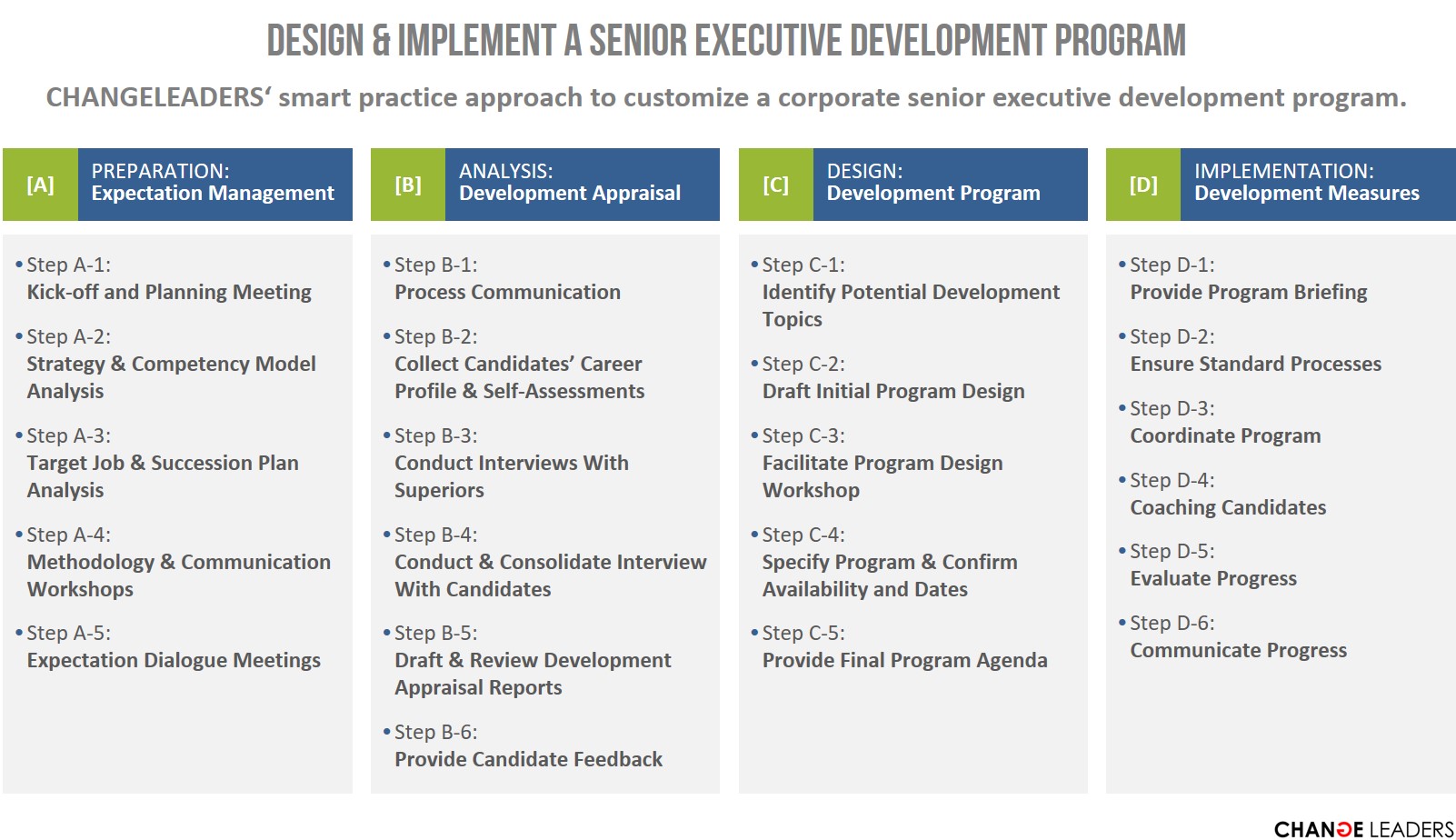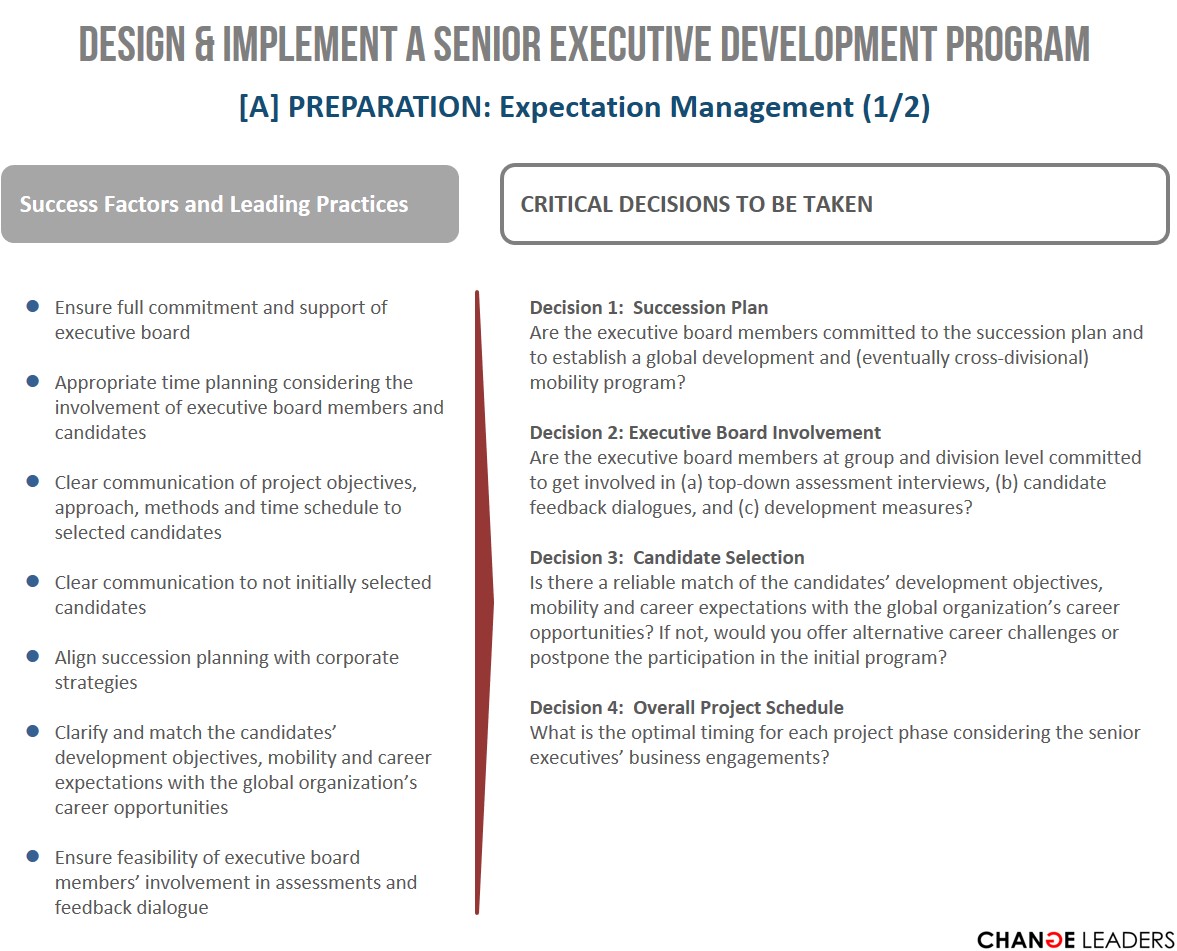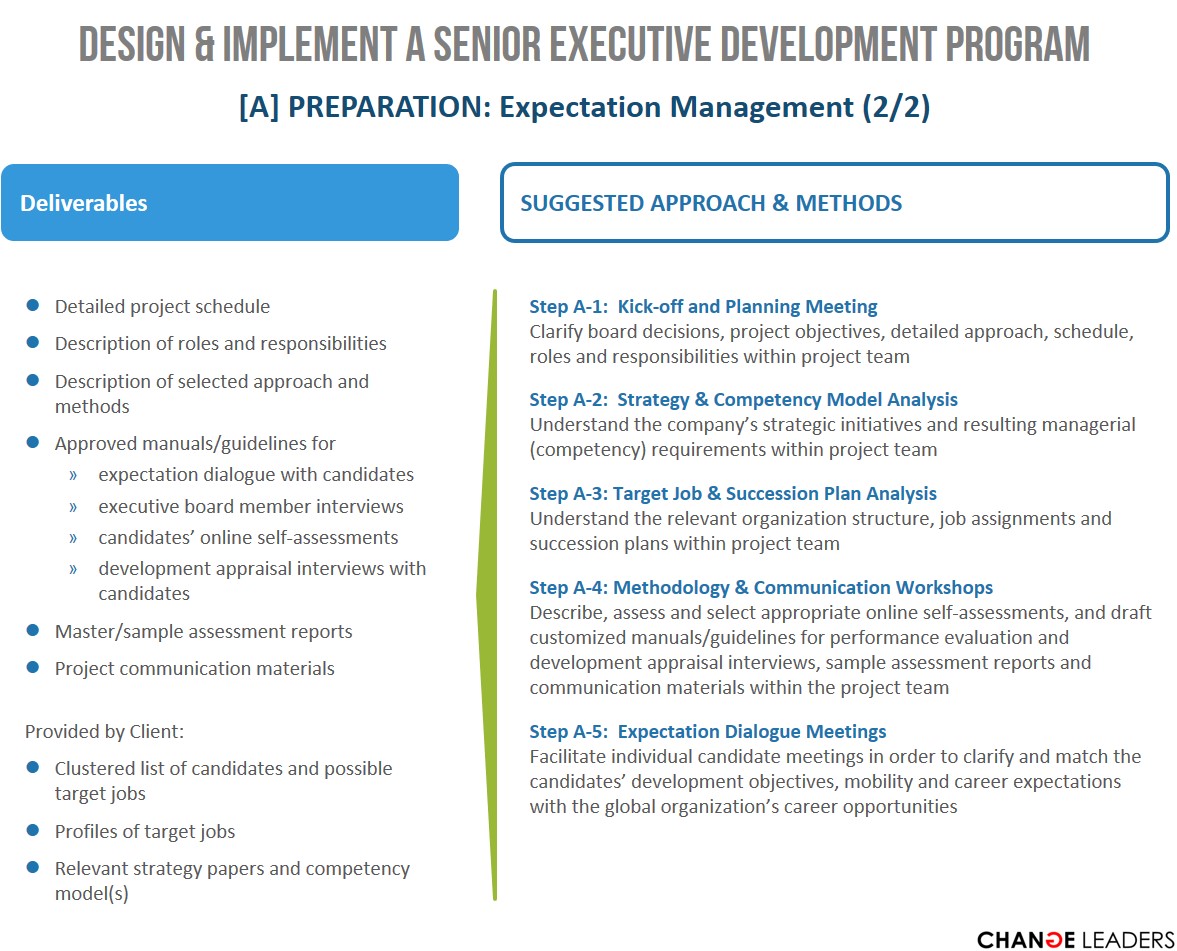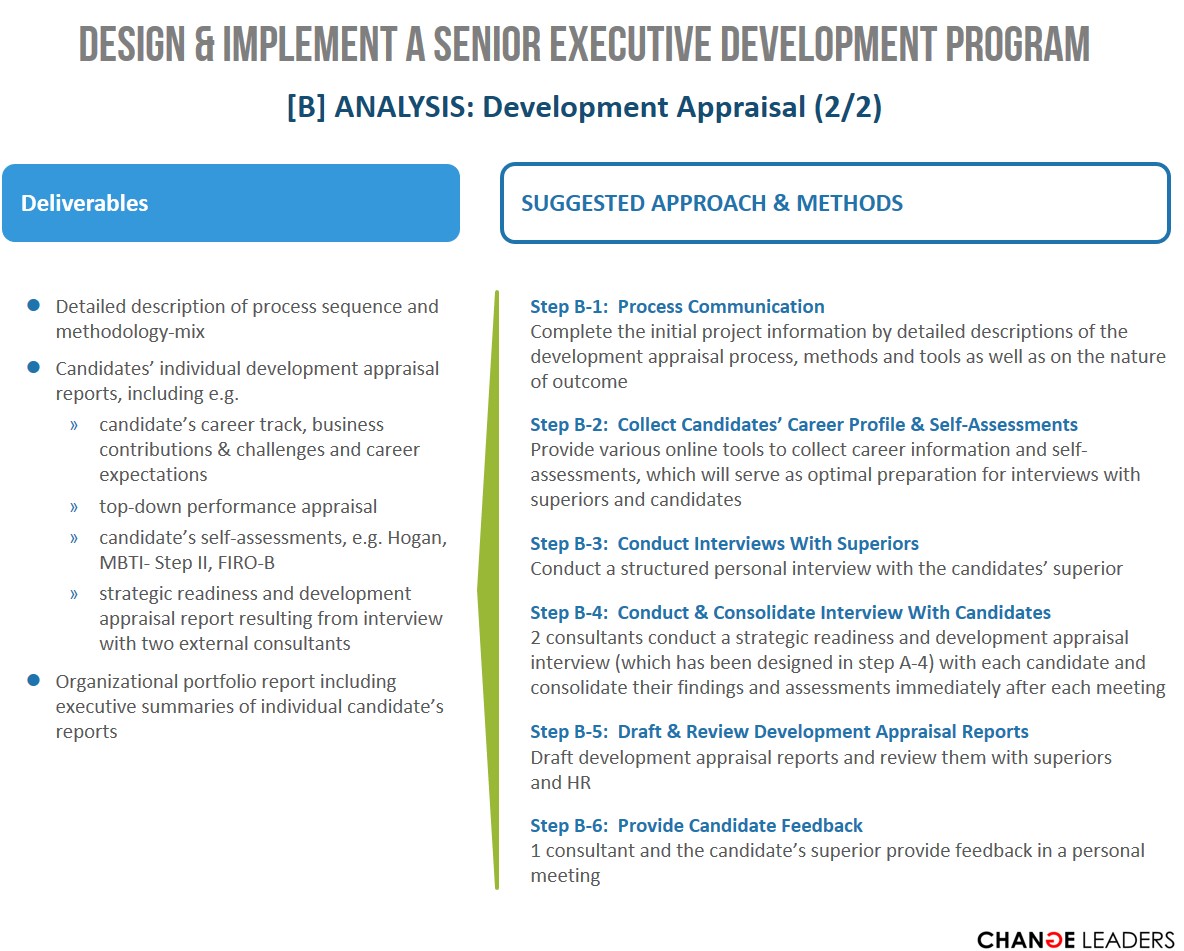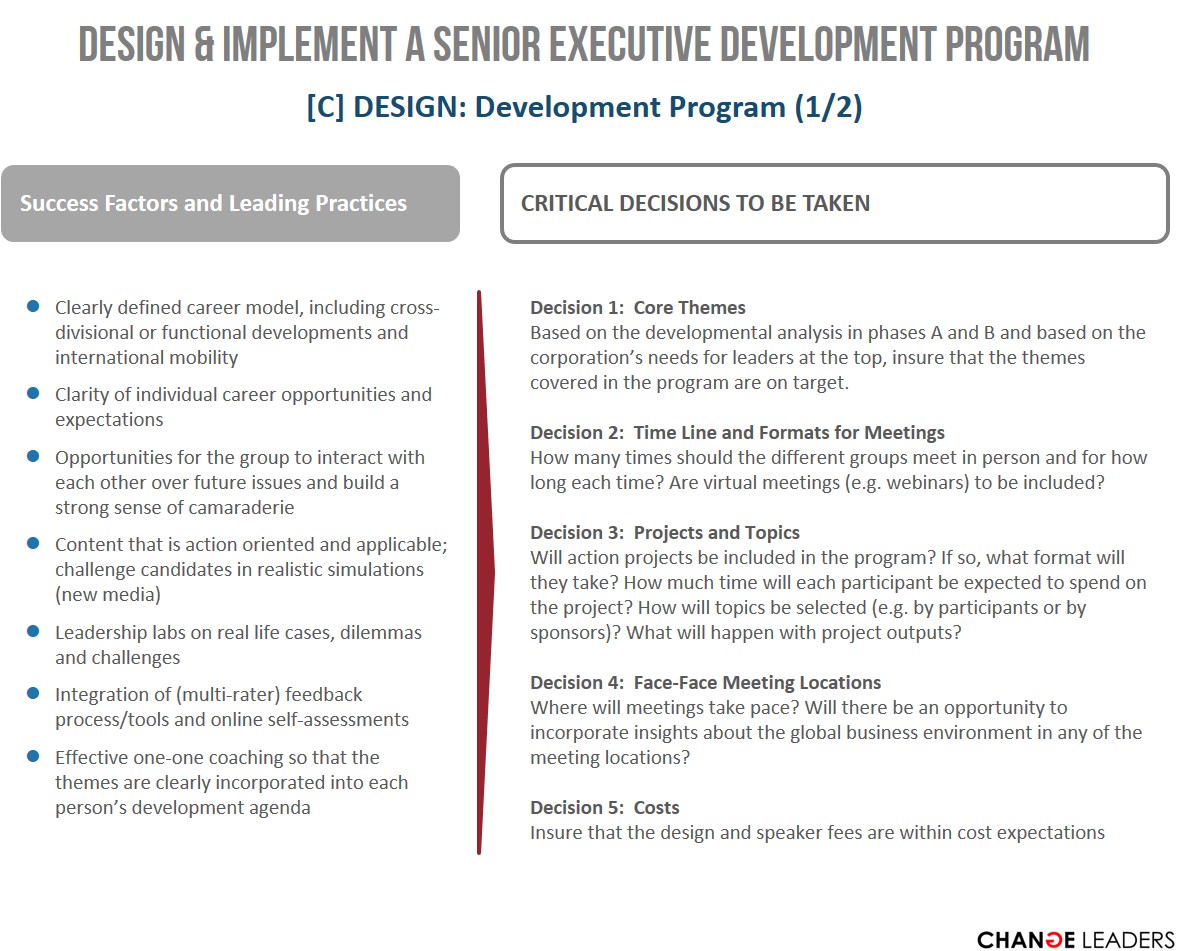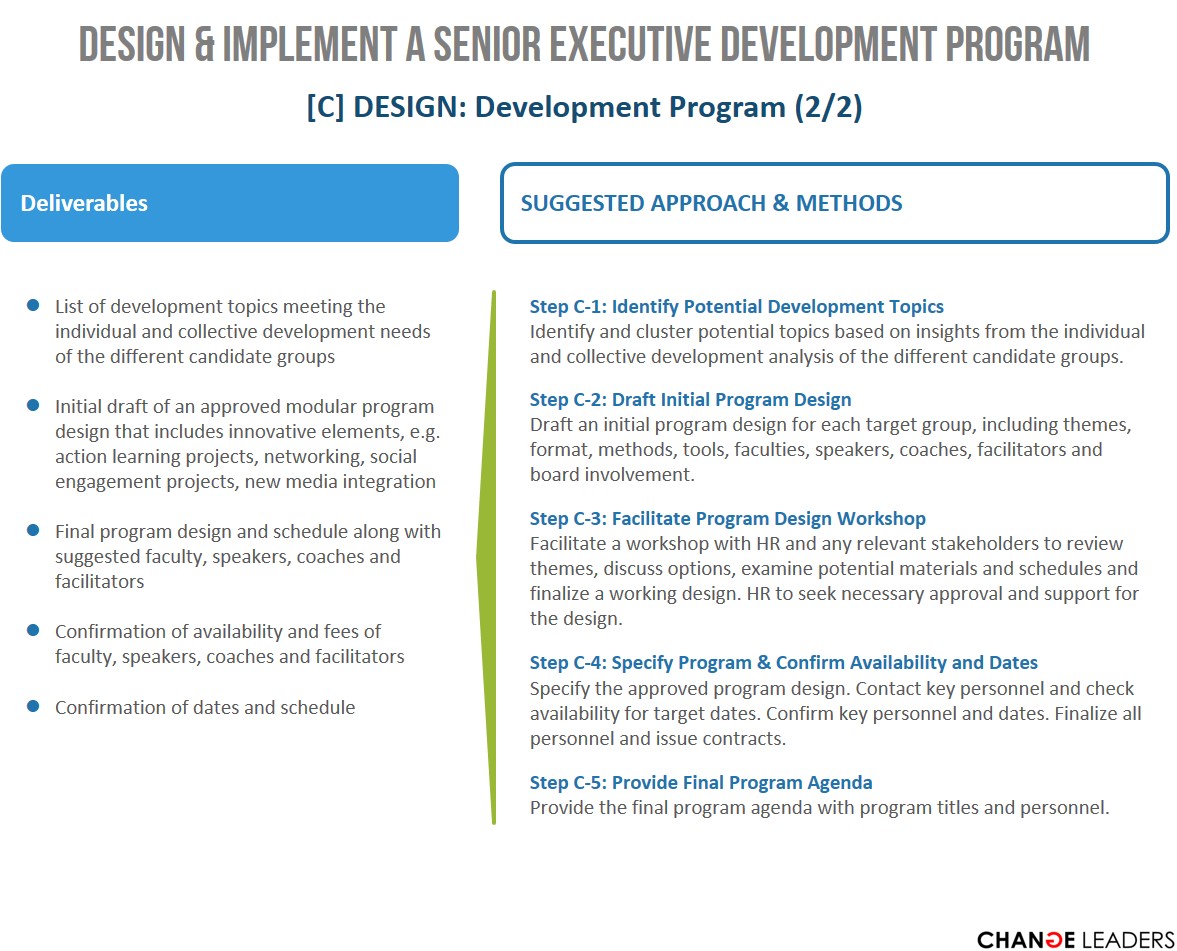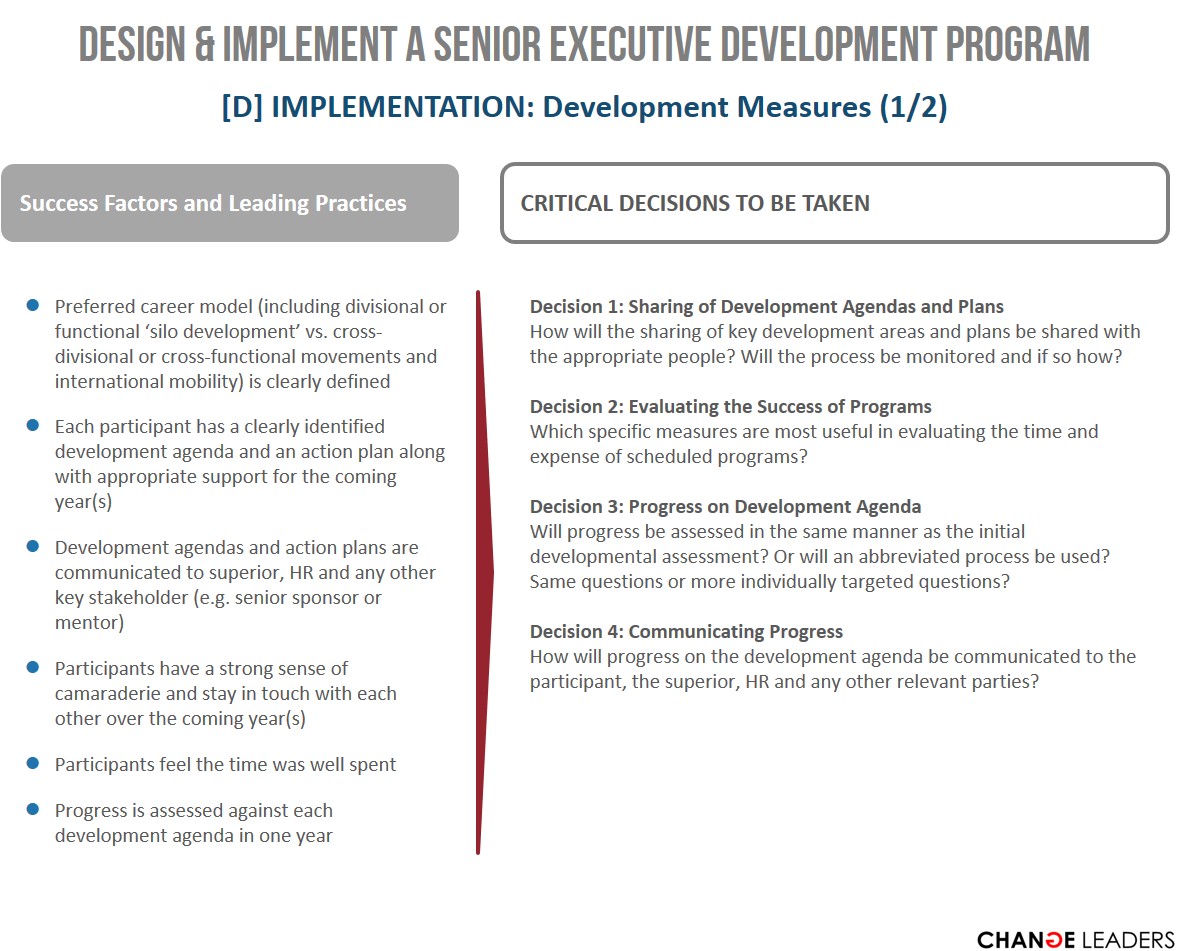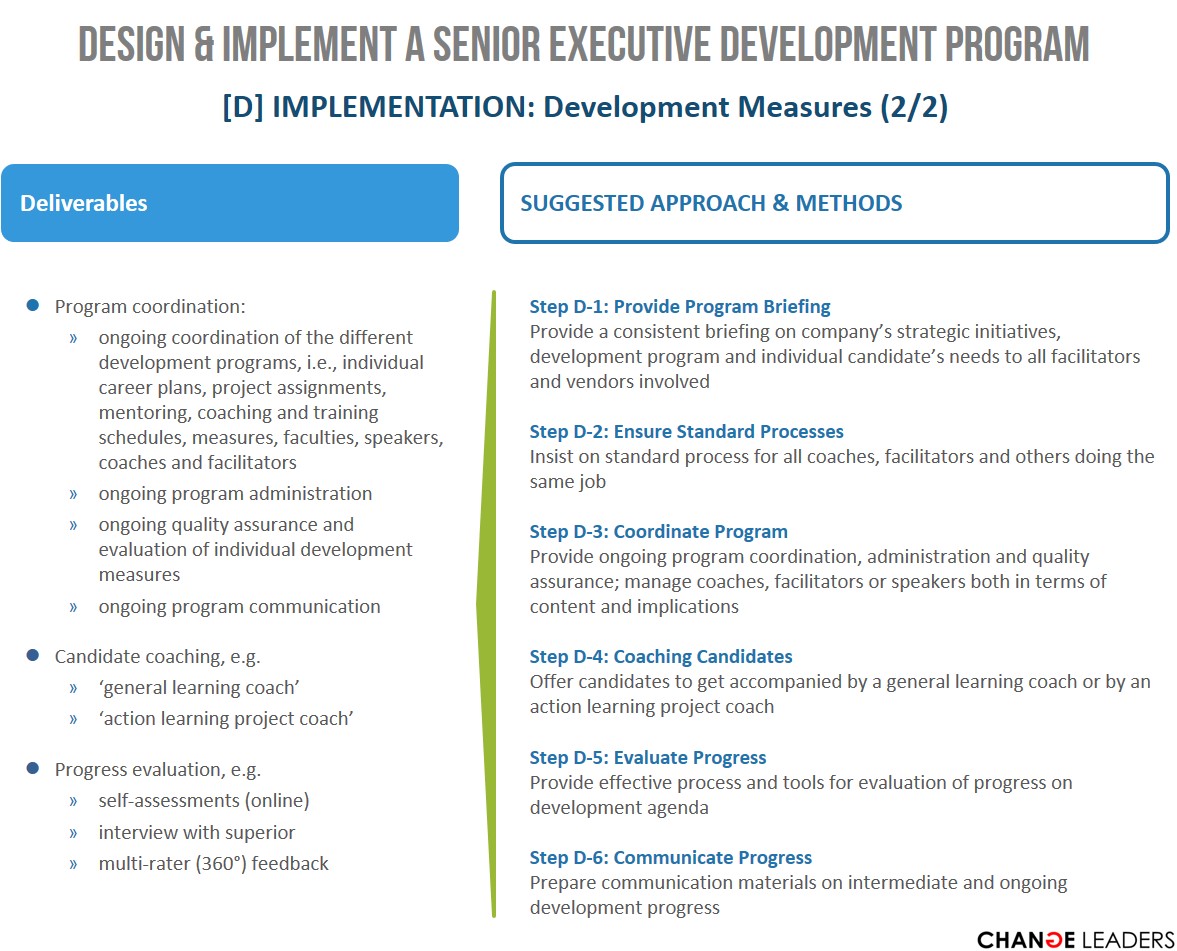How to develop the Next Generation CEO.
The success or failure of a company rests primarily on the strength of its leadership – both the senior team and leaders throughout the organization. In today’s society of rapid transformation and new work environments, leadership roles are changing. CEOs and senior executives have to shape and adapt their own leadership. CHANGELEADERS‘ executive development team is highly competent to set up a long-term and systematic succession planning & development program, and to foster company-wide networking & mobility within senior management.
CHANGELEADERS provide advice to top executives at eye level. Our executive development experts are internationally renowned for their competence in global leadership development.
Verwandte Themen auf dieser Webseite u.a.:
Succession Planning
Leadership Team Effectiveness
Management Audit
A-1:
Kick-off and Planning Meeting
A-2:
Strategy & Competency Model Analysis
A-3:
Target Job & Succession Plan Analysis
A-4:
Methodology & Communication Workshops
A-5:
Expectation Dialogue Meetings
B-1:
Process Communication
B-2:
Collect Candidates’ Career Profile & Self-Assessments
B-3:
Conduct Interviews With Superiors
B-4:
Conduct & Consolidate Interview With Candidates
B-5:
Draft & Review Development Appraisal Reports
B-6:
Provide Candidate Feedback
C-1:
Identify Potential Development Topics
C-2:
Draft Initial Program Design
C-3:
Facilitate Program Design Workshop
C-4:
Specify Program & Confirm Availability and Dates
C-5:
Provide Final Program Agenda
D-1:
Provide Program Briefing
D-2:
Ensure Standard Processes
D-3:
Coordinate Program
D-4:
Coaching Candidates
D-5:
Evaluate Progress
D-6:
Communicate Progress
Under normal circumstances, a well run organization has a systematic approach to succession management for its senior echelons, including succession planning, development and hire planning and programmatic development measures. However, there are times when such an approach needs to be overhauled or even needs a total restart, e.g.:
- after a merger or a significant acquisition, existing plans and methodologies might not match;
- a strategic shift requires new capabilities and current plans and models are too much rooted in the past;
- the succession pipeline has cracks and holes and critical capabilities are missing, hence top management or even the board of directors are getting concerned regarding the related risks;
- on organization has been run very decentralized, maybe on a country basis, and is now implementing global structures but misses the insight into its own leadership bench.
In such cases, a programmatic approach to senior executive development might be required.
TARGET GROUP
- Executives with potential for an Executive Board position
- Executives with potential for managing a segment/division, or corporate function
OBJECTIVES
- Establish a long-term and systematic succession planning and development
- Strengthen company-wide international networking & mobility
INSIGHTS
- Blueprint for Program Design
- Success Factors & Leading Practices
- Critical Decisions to be taken
- Suggested Approach & Methods
- Deliverables
- Ensure full commitment and support of executive board
- Appropriate time planning considering the involvement of executive board members and candidates
- Clear communication of project objectives, approach, methods and time schedule to selected candidates
- Clear communication to not initially selected candidates
- Align succession planning with corporate strategies
- Clarify and match the candidates’ development objectives, mobility and career expectations with the global organization’s career opportunities
- Ensure feasibility of executive board members’ involvement in assessments and feedback dialogue
Decision 1: Succession Plan
Are the executive board members committed to the succession plan and to establish a global development and (eventually cross-divisional) mobility program?
Decision 2: Executive Board Involvement
Are the executive board members at group and division level committed to get involved in (a) top-down assessment interviews, (b) candidate feedback dialogues, and (c) development measures?
Decision 3: Candidate Selection
Is there a reliable match of the candidates’ development objectives, mobility and career expectations with the global organization’s career opportunities? If not, would you offer alternative career challenges or postpone the participation in the initial program?
Decision 4: Overall Project Schedule
What is the optimal timing for each project phase considering the senior executives’ business engagements?
Step A-1: Kick-off and Planning Meeting
Clarify board decisions, project objectives, detailed approach, schedule, roles and responsibilities within project team
Step A-2: Strategy & Competency Model Analysis
Understand the company’s strategic initiatives and resulting managerial (competency) requirements within project team
Step A-3: Target Job & Succession Plan Analysis
Understand the relevant organization structure, job assignments and succession plans within project team
Step A-4: Methodology & Communication Workshops
Describe, assess and select appropriate online self-assessments, and draft customized manuals/guidelines for performance evaluation and development appraisal interviews, sample assessment reports and communication materials within the project team
Step A-5: Expectation Dialogue Meetings
Facilitate individual candidate meetings in order to clarify and match the candidates’ development objectives, mobility and career expectations with the global organization’s career opportunities
- Detailed project schedule
- Description of roles and responsibilities
- Description of selected approach and methods
- Approved manuals/guidelines for
- expectation dialogue with candidates
- executive board member interviews
- candidates’ online self-assessments
- development appraisal interviews with candidates
- Master/sample assessment reports
- Project communication materials
Provided by Client:
- Clustered list of candidates and possible target jobs
- Profiles of target jobs
- Relevant strategy papers and competency model(s)
[B] ANALYSIS: Development Appraisal
- Transparency: clear communication of development purpose, overall process and nature of results
- Strategy & vision alignment of assessment process; linkage to future competency requirements
- Base the assessment on multiple sources
- candidate’s career track, business contributions & challenges and career expectations (online)
- multi-rater (360°) feedback on leadership and collaboration; at least: top-down performance appraisal (personal interview with superior)
- candidate’s self-assessments (online)
- strategy and business-focused candidate interview with two external consultants
- Joined appraisal feedback and coaching by external consultant and superior
Decision 1: Appraisal Process & Methodology-Mix
Decide on the proposed process steps and methods/tools, especially on use of multi-rater feedback tools vs. interview with superior; mix of online assessment tools; semi-structured ‘strategic readiness interview’ guideline)
Decision 2: Appraisal Report Format
Decide on the proposed report formats for candidate feedback, superior and HR (e.g. executive summaries, detailed analyses at individual and portfolio level)
Decision 3: Appraisal Feedback Process
Decide on the process and team for the entire reporting and feedback process (e.g. consolidation of results, review with superior and HR, joined appraisal feedback and coaching by external consultant and superior)
Decision 4: Sequence, Timing & Locations
Decide on the sequence, timing and location for both, the different assessment modules and feedback meetings (e.g. collect candidate’s career profile and conduct self-assessments before conducting the performance appraisal interview with superior; conducting candidate interviews and feedback meetings on site)
Step B-1: Process Communication
Complete the initial project information by detailed descriptions of the development appraisal process, methods and tools as well as on the nature of outcome
Step B-2: Collect Candidates’ Career Profile & Self-Assessments
Provide various online tools to collect career information and self-assessments, which will serve as optimal preparation for interviews with superiors and candidates
Step B-3: Conduct Interviews With Superiors
Conduct a structured personal interview with the candidates’ superior
Step B-4: Conduct & Consolidate Interview With Candidates
2 consultants conduct a strategic readiness and development appraisal interview (which has been designed in step A-4) with each candidate and consolidate their findings and assessments immediately after each meeting
Step B-5: Draft & Review Development Appraisal Reports
Draft development appraisal reports and review them with superiors
and HR
Step B-6: Provide Candidate Feedback
1 consultant and the candidate’s superior provide feedback in a personal meeting
- Detailed description of process sequence and methodology-mix
- Candidates’ individual development appraisal reports, including e.g.
- candidate’s career track, business contributions & challenges and career expectations
- top-down performance appraisal
- candidate’s self-assessments, e.g. Hogan, MBTI- Step II, FIRO-B
- strategic readiness and development appraisal report resulting from interview with two external consultants
- Organizational portfolio report including executive summaries of individual candidate’s reports
[C] DESIGN: Development Program
- Clearly defined career model, including cross-divisional or functional developments and international mobility
- Clarity of individual career opportunities and expectations
- Opportunities for the group to interact with each other over future issues and build a strong sense of camaraderie
- Content that is action oriented and applicable; challenge candidates in realistic simulations (new media)
- Leadership labs on real life cases, dilemmas and challenges
- Integration of (multi-rater) feedback process/tools and online self-assessments
- Effective one-one coaching so that the themes are clearly incorporated into each person’s development agenda
Decision 1: Core Themes
Based on the developmental analysis in phases A and B and based on the corporation’s needs for leaders at the top, insure that the themes covered in the program are on target.
Decision 2: Time Line and Formats for Meetings
How many times should the different groups meet in person and for how long each time? Are virtual meetings (e.g. webinars) to be included?
Decision 3: Projects and Topics
Will action projects be included in the program? If so, what format will they take? How much time will each participant be expected to spend on the project? How will topics be selected (e.g. by participants or by sponsors)? What will happen with project outputs?
Decision 4: Face-Face Meeting Locations
Where will meetings take pace? Will there be an opportunity to incorporate insights about the global business environment in any of the meeting locations?
Decision 5: Costs
Insure that the design and speaker fees are within cost expectations
Step C-1: Identify Potential Development Topics
Identify and cluster potential topics based on insights from the individual and collective development analysis of the different candidate groups.
Step C-2: Draft Initial Program Design
Draft an initial program design for each target group, including themes, format, methods, tools, faculties, speakers, coaches, facilitators and board involvement.
Step C-3: Facilitate Program Design Workshop
Facilitate a workshop with HR and any relevant stakeholders to review themes, discuss options, examine potential materials and schedules and finalize a working design. HR to seek necessary approval and support for the design.
Step C-4: Specify Program & Confirm Availability and Dates
Specify the approved program design. Contact key personnel and check availability for target dates. Confirm key personnel and dates. Finalize all personnel and issue contracts.
Step C-5: Provide Final Program Agenda
Provide the final program agenda with program titles and personnel.
- List of development topics meeting the individual and collective development needs of the different candidate groups
- Initial draft of an approved modular program design that includes innovative elements, e.g. action learning projects, networking, social engagement projects, new media integration
- Final program design and schedule along with suggested faculty, speakers, coaches and facilitators
- Confirmation of availability and fees of faculty, speakers, coaches and facilitators
- Confirmation of dates and schedule
[D] IMPLEMENTATION: Development Measures
- Preferred career model (including divisional or functional ‘silo development’ vs. cross-divisional or cross-functional movements and international mobility) is clearly defined
- Each participant has a clearly identified development agenda and an action plan along with appropriate support for the coming year(s)
- Development agendas and action plans are communicated to superior, HR and any other key stakeholder (e.g. senior sponsor or mentor)
- Participants have a strong sense of camaraderie and stay in touch with each other over the coming year(s)
- Participants feel the time was well spent
- Progress is assessed against each development agenda in one year
Decision 1: Sharing of Development Agendas and Plans
How will the sharing of key development areas and plans be shared with the appropriate people? Will the process be monitored and if so how?
Decision 2: Evaluating the Success of Programs
Which specific measures are most useful in evaluating the time and expense of scheduled programs?
Decision 3: Progress on Development Agenda
Will progress be assessed in the same manner as the initial developmental assessment? Or will an abbreviated process be used? Same questions or more individually targeted questions?
Decision 4: Communicating Progress
How will progress on the development agenda be communicated to the participant, the superior, HR and any other relevant parties?
Step D-1: Provide Program Briefing
Provide a consistent briefing on company’s strategic initiatives, development program and individual candidate’s needs to all facilitators and vendors involved
Step D-2: Ensure Standard Processes
Insist on standard process for all coaches, facilitators and others doing the same job
Step D-3: Coordinate Program
Provide ongoing program coordination, administration and quality assurance; manage coaches, facilitators or speakers both in terms of content and implications
Step D-4: Coaching Candidates
Offer candidates to get accompanied by a general learning coach or by an action learning project coach
Step D-5: Evaluate Progress
Provide effective process and tools for evaluation of progress on development agenda
Step D-6: Communicate Progress
Prepare communication materials on intermediate and ongoing development progress
- Program coordination:
- ongoing coordination of the different development programs, i.e., individual career plans, project assignments, mentoring, coaching and training schedules, measures, faculties, speakers, coaches and facilitators
- ongoing program administration
- ongoing quality assurance and evaluation of individual development measures
- ongoing program communication
- Candidate coaching, e.g.
- ‘general learning coach’
- ‘action learning project coach’
- Progress evaluation, e.g.
- self-assessments (online)
- interview with superior
- multi-rater (360°) feedback



